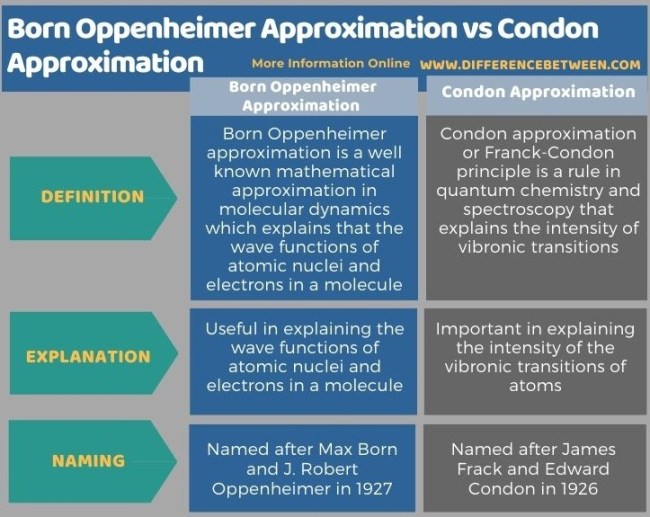Thekey difference奥本海默近似出生和康登之间approximation is that天生的oppenheimer近似可用于解释分子中原子核和电子的波功能,而condon近似对于解释的强度很重要。vibronic transitionsof atoms.
Born Oppenheimer近似和CONDON近似或Franck-Condon原理的术语是量子化学中的重要术语。
CONTENTS
1.Overview and Key Difference
2.What is Born Oppenheimer Approximation
3.什么是condon近似
4.Side by Side Comparison – Born Oppenheimer Approximation vs Condon Approximation in Tabular Form
5.概括
What is Born Oppenheimer Approximation?
Born Oppenheimer approximation is a well-known mathematical approximation in molecular dynamics. The term is used mainly in quantum chemistry and molecular physics. It explains that the wave functions of atomic nuclei and electrons in a molecule can be treated separately depending on the fact that the nuclei are heavier than the electrons. The approximation approach was named after Max Born and J. Robert Oppenheimer in 1927. The origin of this approximation was in the early period ofquantum mechanics.
The Born Oppenheimer approximation is useful in quantum chemistry to speed up the computation of the molecular wavefunctions and other properties for large molecules. However, we can observe some cases where the assumption of separable motion no longer holds. This makes the approximation invalid (also called a breakdown). However, it was used as a starting point for other refined methods.
In the field ofmolecular spectroscopy, we can use the Born Oppenheimer approximation as the sum of independent terms of molecular energy such as Etotal= Eelectronic+ Evibrational+ E核spin. Typically, nuclear spin energy is very small, so it is omitted from the calculations. The term electronic energies or Eelectronicinclude kinetic energy, interelectronic repulsions, internuclear repulsions, and electron-nuclear attractions, etc.
Generally, Born Oppenheimer approximation tends to recognize large differences between the electron mass and the masses of atomic nuclei where the time scales of their motion are also considered. E.g. at a given amount of kinetic energy, the nuclei tend to move slower than the electrons. According to Born Oppenheimer approximation, the wavefunction of a molecule is the product of an electronic wavefunction and a nuclear wavefunction.
什么是condon近似?
condon近似或弗朗克 - 康登原理是量子化学和光谱法的规则,该规则解释了强度vibronic transitions. We can define vibronic transitions as the simultaneous changes in electronic and vibrational energy levels of a molecule that takes place due to the absorption or the emission of a photon of the appropriate energy.

图01:基于弗朗克 - 康登近似的能量图
Condon approximation states that during an electronic transition that takes place in an atom, a change from one vibrational energy level to another level usually happens if the two vibrational wave functions tend to overlap in significant amounts.
这一原则是由詹姆斯·弗拉克(James Frack)和爱德华·康登(Edward Condon)于1926年开发的。该原则具有完善的半古典解释,具体取决于这些科学家的原始贡献。
What is the Difference Between Born Oppenheimer Approximation and Condon Approximation?
Oppenheimer近似和CONDON近似或Franck-Condon原理的术语是量子化学中的重要术语。天生的oppenheimer近似和condon近似之间的关键差异是,天生的oppenheimer近似可用于解释分子中原子核和电子的波功能,而condon近似对于解释原子振动过渡的强度很重要。
Below is a summary of the difference between Born Oppenheimer approximation and Condon approximation in tabular form.

概括– Born Oppenheimer Approximation vs Condon Approximation
Born Oppenheimer近似和CONDON近似或Franck-Condon原理的术语是量子化学中的重要术语。天生的oppenheimer近似和condon近似之间的关键差异是,天生的oppenheimer近似可用于解释分子中原子核和电子的波功能,而condon近似对于解释原子振动过渡的强度很重要。
Reference:
1.“ 10.1:出生的脑近似。”Chemistry LibreTexts, Libretexts, 10 Aug. 2020,Available here.
Image Courtesy:
1. “Franck Condon Diagram” By Samoza(CC BY-SA 3.0)viaCommons Wikimedia


发表评论